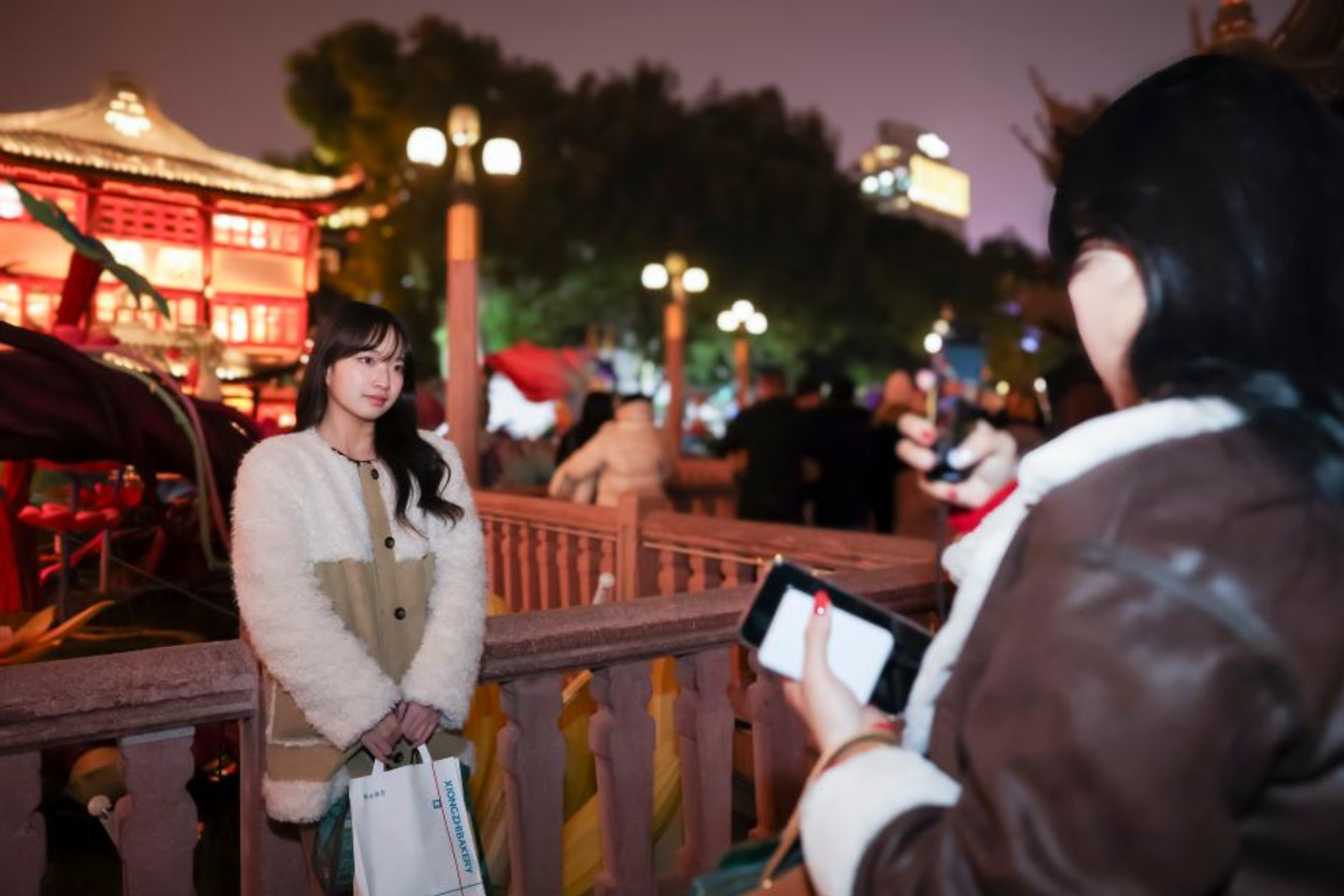In Chenjiagou, tai chi is everything. The city is the birthplace of Chen style tai chi, the oldest of tai chi’s five traditional family styles, one known for adhering to its origins as a combat art well into the modern day. It is, in no uncertain terms, the most historically significant site for China’s (and perhaps the world’s) most practiced martial art. It’s also totally empty.
Out of the village’s 40,000 residents, one mentions to me, approximately 30,000 practice Chen style tai chi. Riding in a tour buggie down the street, I’m struck by the town’s commitment to its identity. Empty tai chi hotels rise high into the sky. Uninhabited storefronts built in the old-school Chinese style line the major roads, pasted with designs of tai chi stances and postures. You can catch the biweekly tai chi show at tai chi park, or train in the secluded tai chi boxing grounds. None of them seem to have any guests.

A film crew sets up at Chenjiagou’s central walkway feature.
All this is not to say that Chenjiagou’s tai chi industry — tourism included — isn’t impressive. Tai chi economy is the lifeblood of the whole village, from tai chi training centers, to medicine, to the manufacturing of tai chi goods. Tai chi is also the sole characteristic that separates Chenjiagou from unremarkable neighboring towns. And yet somehow, the success of Chenjiagou’s tai chi industry is also the reason for its abandoned aesthetic.
Chenjiagou’s small-time celebrity is relatively newfounded, the infrastructure itself having just sprung up over the past couple decades. Now the city is preparing for the future at breakneck speeds. Perhaps following the example of the nearby Shaolin Temple, now a source of revenue worth millions each year, and whose abbot has been dubbed the “CEO monk”, small town Chenjiagou has big dreams. Two recent tai chi projects received a total of five billion RMB of funding, and that spirit shows in the newly-erected towers, statues, structures, and sites that cover Chenjiagou, even if the daily foot traffic isn’t yet able to match it.

At the center of it all is Wang Changjiang. Master Wang is the oldest, most direct carrier of the Chen tai chi lineage, and as a result, the de facto figurehead of the town. He teaches tai chi out of his martial arts studio home, located at the end of a long scenic tai chi promenade that constitutes the center of Chenjiagou. There, he trains disciples, and works to preserve the art form that has defined his life.
“Chen family tai chi originated from Chenjiagou — it’s our cultural artifact, and it bears the history of our town,” he says. “Chen family tai chi and Chenjiagou share an inseparable, intrinsic relationship. I myself am the grandson of Wang Yan, a proud disciple of Chen Yanxi, of the eighth generation of Chen family tai chi. Tai chi has given the people here confidence in our culture, and improved our quality of life overall.”
Watching Master Wang perform tai chi is like watching a concert pianist perform his pocket concerto, or a Formula One driver curve around a turn. Every movement is perfectly mapped out, intentional, and practiced thousands upon thousands of times.
Relax your body. Relax your legs, your hips, arms. Your tongue should make contact with the roof of your mouth. Relax your focus, but let the eyes be like lights.
These were all things he told me during our brief period of study.
Without a peaceful mind, there will be no peaceful body.
Later, I was stunned to watch him execute high-level tai chi movements. Punctuated exhales of air sent his hands and fists quivering at the end of strikes. He floated at high speeds through his movements, watching everything and nothing. And his eyes, I was surprised to notice, really were like lights.

Visual reference, if you don’t believe me about the eyes.
Tai chi is popular all over China, but 99% of practitioners are in it for health benefits and low-impact exercise, rather than to achieve martial arts mastery. Old folks in every city — if they’re not gathering in the evening for group square dancing — are trekking out in the early AM to subway stops, parks, and KFC forecourts to practice tai chi. Do a little every day, and you’ll grow to be a healthy, wizened nonagenarian with great circulation, is the generally accepted idea.
Having a long background in martial arts and combat sports, from Shaolin to Brazilian jiujitsu, I’d always been fascinated by the dying practice of combat tai chi application. At one point I mentioned this to the master, asking him if he could teach me a combat maneuver, or a self-defense application to the movements we were doing. He didn’t seem to understand at all, and it took several repeated requests from a native Chinese speaker for him to realize I wanted to learn a “kung fu move.”
“There are no moves to teach,” he told me. You just do it, and do it, and then you have it.

A dedicated tai chi training zone at a historical park. In the middle is a heavy cinderblock to build lifting strength.
I was naturally skeptical, pointing to the moves I’d learned in the past: if A does this, B does this. Master Wang shook his head and asked me to hit him. Scared to embarrass the old man, grandfather to many, I pushed my hand towards him gingerly. In one movement, he snapped it out of the air, and isolated my fingers in a joint lock. One more movement, and I was on my ass at his feet.
Chen tai chi’s adherence to its martial roots reflects its history as the oldest classical style of tai chi — a history that its practitioners value immensely. Chenjiagou’s surrounding province of Henan isn’t a sprawling urban metropolis. Miles of farmland and countryside constitute large swaths of its area, and while it isn’t one of China’s poorest provinces, it isn’t one of the wealthiest either. It faces a classic struggle, now well-known to cities across the country: how to translate historical significance into modern-day wealth and quality of life.

Outside of scenic tai chi tourism sites, Henan life continues as usual.
Getting international travel documents isn’t easy in China, and most families opt for more attainable domestic vacations. Touring the birthplaces of obscure foods, historical figures, or literary phenomena is all much more common than you’d expect (also in Henan, I was fortunate enough to visit a small replica of the ancient Lord Bao’s court, where I was allowed to recreate the famous slapping and throwing of wooden tiles to announce a criminal verdict).
Compared to other would-be tourist hotspots in China, the title “birthplace of tai chi” is a veritable jackpot. City planners have poured everything into that identity, and the whole town pulsates with tai chi energy. Still, the tourism, though it’s on the rise, isn’t quite there yet. Photos of the city’s landmarks, alone and majestic, aren’t staged. There just aren’t many people wandering around, outside of major public holidays. I counted a total of two modest tour groups in my time there. I’d guess there haven’t ever been enough to fully book the town’s towering tai chi-themed hotel, whose idle front desk attendants always seem unprepared to see you.

Rebecca Vorisek on a not-yet-inhabited tourist street while hosting a program for the Henan tourism bureau.
And yet, the town’s citizens aren’t fazed. There’s an intrinsic belief in the value of their cultural heritage, and a valid one at that. Master Wang’s 16-year-old granddaughter Wang Xuelian, like many Chenjiagou-ers, loves her town:
I feel great about Chenjiagou. The atmosphere is good, and walking around you can see people in tai chi clothes everywhere. Early or late, people are practicing tai chi. It’s not noisy, and life is comfortable. But it’s not as casual as it used to be, and many of the village’s homes have been built into hotels and restaurants. It’s not the same as when I was a child, and that’s a bit strange.
But I still practice tai chi for self-cultivation and exercise. There’s something indescribable there. I haven’t decided for sure if I’ll stay in Chenjiagou when I grow up, but I think I will. I’ll do my favorite thing in the most familiar place. The most important thing is to pass on true traditional Chen tai chi with my tai chi family.
You might also like:
![]() Saving Southern Shaolin: Preserving the Ancient Art of QigongArticle Feb 03, 2018
Saving Southern Shaolin: Preserving the Ancient Art of QigongArticle Feb 03, 2018
















